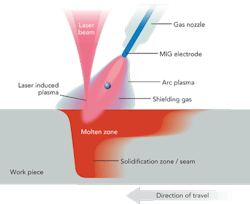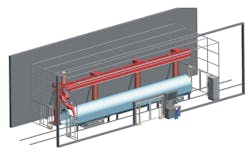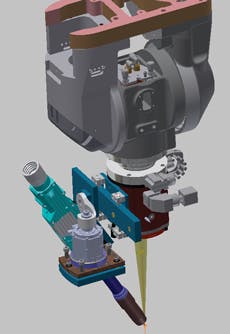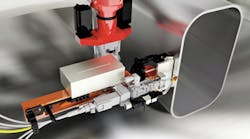Laser hybrid welding: Powerful factory floor process
Joining automation, process control, and metallurgy
Norbert Hoeppe and Gard Van Antwerp
More Industrial Laser Solutions Articles |
Laser welding in commercial furniture manufacturing Laser-GMA hybrid joining of thick high-strength steels Laser processing steel floors for containers |
Laser hybrid welding (LHW) is only one of many exciting material processing applications available to the industry right now through knowledgeable laser automation technique specialists. LHW can provide very low distortion along with high welding speeds and great mechanical properties. Automation of LHW can be enhanced by high accuracy large-scale gantry kinematics, integrated beam guidance, offline programming, and much more, to bring manufacturing to state-of-the-art levels.
The LHW process (FIGURE 1) is a proven method of combining the characteristics of arc welding processes, such as metal inert gas (MIG) gas metal arc welding, and lasers to get results that neither process can achieve alone.
The MIG process has a high deposition rate that can help fill gaps in a weld joint, while the laser has pinpoint energy density that helps enable fusion in a deeper joint, often while eliminating the need for special joint shape preparation.
- LHW has several advantages:
- Deep, narrow welds
- Higher welding speeds
- Lower heat input
- Reduced heat-affected zone
- Reduced distortion
- High-quality weld seams with good appearance and physical properties
- Little or no rework
- Better control of the root, sometimes allowing full fusion without need to weld the back side
Applications for LHW include rail vehicles (e.g., side walls for railway wagons), containers, heavy construction (such as high-strength crane booms), building construction, automobiles, and in shipbuilding. Many other applications are sure to open themselves up to shops that master the process.
Laser source
LHW requires good power from a fiber-guided, continuous wave (not pulsed) laser source. A typical range for LHW is 8 to 16 kW, with more power required as the welded material becomes thicker. There are a limited number of laser manufacturers that are now producing lasers of high-enough power to be used in LHW. The fiber-guided lasers provide flexibility in handling, allowing movement of the optics as opposed to the part. A CO2 laser could be used, but would probably require that the part be moved under the optics, and power efficiency is a consideration. Typically, wavelengths between 880 nm and up to ~1100 nm are used. When combined with the need for high power, this is a good fit for fiber lasers or disk lasers. Regarding duty cycle, sometimes a welded seam takes 8 to 10 min, changing the parts might require ~5 minutes, and then it's on to the next seam, making the cooling systems critical.
Welding optics
While the laser source will dictate the power available for work, the beam guiding systems, or optics, will provide the control of the beam. Very precise control systems are needed in order for the optics to deliver and form the beam for the required application. In addition to the required high precision, the optics used for welding must also be built rugged and robust for severe conditions. Operating in conjunction with the MIG torch, the optics system for LHW must be protected from weld spatter by cross-jet tooling and protective lenses.
Kinematics
Key to flexible, high-quality LHW cells are the kinematics: the moving automation that carries the laser optics and welding torch along the sometimes intricate paths of the welding seam. High path accuracy and repeatability are required, making the rigidity of a gantry portal system useful. Designed for large work envelopes, a gantry system accommodates big workpieces while keeping floor space clear (FIGURE 2). This configuration also allows maximum flexibility for 3D motion of the robot around the weldment.
Additionally, the LHW head assembly (FIGURE 3) is quite heavy, so the robot payload has to be appropriately rated, and the entire gantry system engineered robustly enough to handle dynamic loading and still deliver the required accuracy.
Programming
Ease and speed of programming the welding for different parts is critical to any production operation. The ability to import drawing files and quickly create the robot program while not impacting the ongoing production is crucial to keeping capex dollars working. This kind of offline programming is an important aspect of optimizing uptime of automated work cells. Programs like Reis Robotics' ProVis offer visualization of the work cell, robot, and workpiece, enabling the programmer to prepare a detailed program for a part without impacting production.
It is important to note that the robot controller and automation included in the LHW systems described here allow the integrated programming and control of the welding power supply, laser equipment, shielding gas, vision systems, etc., in addition to the precise control of the kinematics. While there is complex coordination within the system, Reis RobotStarVI control system and the new reisPAD teach pendant make the programming intuitive, straightforward, and fast.
Safety
Critically important to the factory floor, safety is a key concern when using the high laser powers typically needed for LHW. Laser cabins with special sensoring and shutoff controls for errant laser beams are a fundamental requirement. Even well-trained staff must have the protection of fail-safe emergency controls that can be implemented in the work cell design. Patented Reis Laser Spy monitoring ensures that laser beams can't get outside of the laser cabin, adding safety and reducing risk in the shop.
Application in the field
Reis Robotics has delivered a system to a factory for the welding of construction equipment (FIGURE 4), specifically the long boom section of a heavy lift mobile crane (see also FIG. 2). Using a high-strength, fine-grained steel alloy, the company is able to reduce the weight of its crane boom, which is significant when dealing with up to 72 m of telescoping section boom height. The material and design, however, results in a boom with even better mechanical properties than the conventional process, even while the welding speeds are doubled.
In the conventional method of welding these boom segments, 2 to 3 passes of MAG welding were required, at welding speeds of less than 0.5 m/min. LHW allows fit up of the two half-shells using local clamping. No measurable distortion occurs due to welding; complete penetration of the 15-mm-thick square butt weld joint is achieved in a single pass at speeds over 1 m/min, and the root side requires no secondary operation. The process can accommodate a 0 to 1 mm weld gap with no parameter changes.
By using a linear robot hanging from a gantry, the two longitudinal welds that join the half-shells can be accessed and precisely welded. The arc welding nozzle and laser optics must be manipulated by the robot, as well as the seam tracking, gas and electrical plumbing, and cable support. The gantry layout allows pre-fitted workpieces to enter the laser cabin on rail-mounted carts, ensuring smooth handling and maximum up-time of the laser system. The thoughtful application of LHW, along with the state-of-the-art design and material selection, provide an advantage for this manufacturer.
Ready for the welding shop
Many welding job shops and contract manufacturers are beginning to recognize the importance of offering the most advanced manufacturing processes, such as laser cutting and welding, to their clients. This trend is being facilitated and motivated by high-quality requirements; the decreasing expense of laser systems (laser equipment investment is 30 to 40% lower than in 2006, and fiber lasers require one-third of the power consumption of CO2 lasers); a better ability to prefabricate parts to the tight tolerances needed for laser processes; and new, improved laser material processing systems. By putting capabilities on the floor that many of their competitors don't have, these forward-thinking shops are creating a marketing and technical advantage.
However, laser hybrid welding is also at a critical nexus point of automation, process control and metallurgy. Exhaustive research and development have been done around this process, and it would be reinventing the wheel to enter into the fray without an automation partner who can provide the technical support needed for efficient and productive implementation of a LHW system. ✺
Norbert Hoeppeis the laser sales manager at Reis GmbH & Co. Maschinenfabrik, andGard Van Antwerp([email protected]) is laser applications manager for Reis Robotics USA.
More Industrial Laser Solutions Current Issue Articles
More Industrial Laser Solutions Archives Issue Articles




